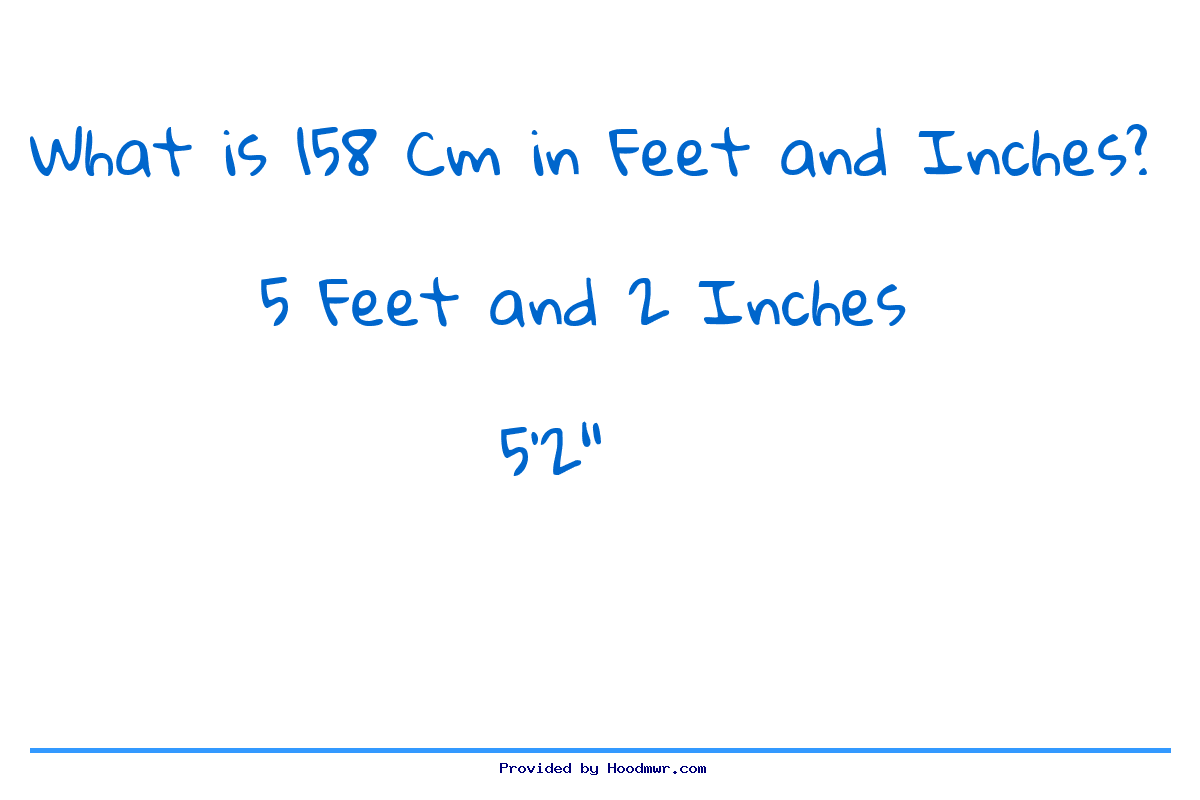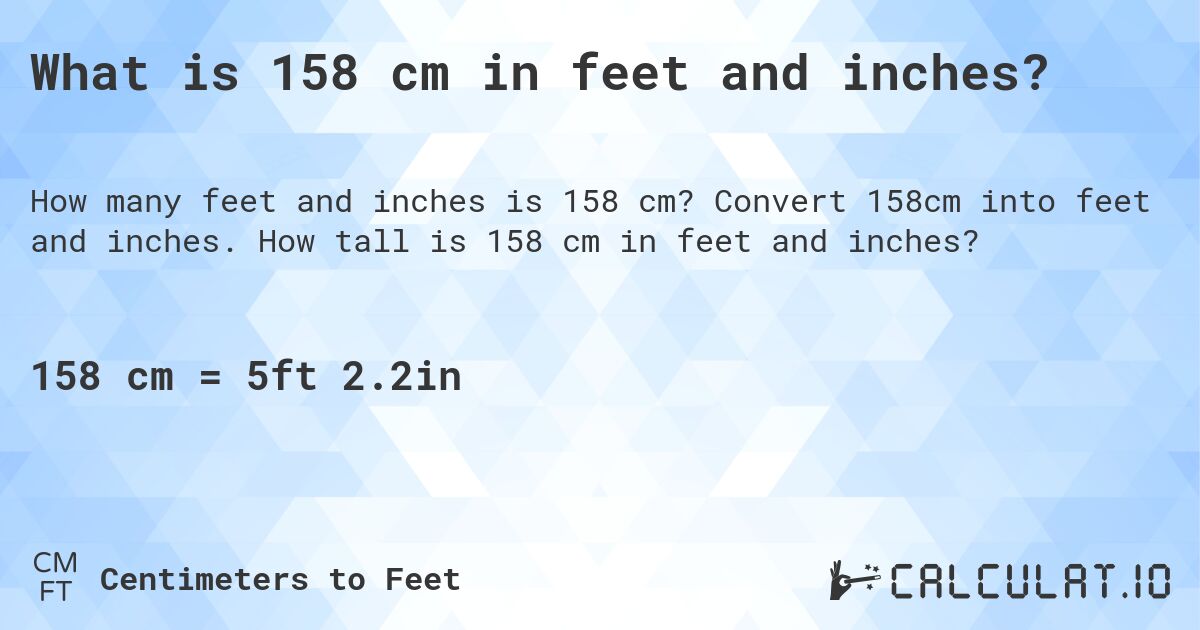Ever found yourself wondering just how tall 158 cm is in the more familiar units of feet and inches? Knowing precisely how to convert between metric and imperial measurements is essential for a wide array of everyday tasks, from understanding medical reports to DIY home improvement projects.
The need to translate centimeters into feet and inches arises more often than one might think. Whether you're trying to visualize the height of an object described in metric terms, or comparing your own height to someone who uses a different measurement system, the ability to perform this conversion is invaluable. So, lets delve into the specifics. 158 centimeters is approximately equal to 5 feet and 2.2 inches. This conversion isn't just a matter of curiosity; it's a practical skill that bridges the gap between different measurement systems.
| Measurement Conversion - 158 cm |
|---|
| Centimeters (cm): 158 cm |
| Feet (ft): Approximately 5.18 feet |
| Feet and Inches: 5 feet and 2.2 inches (approx.) |
| Conversion Formula (cm to ft): ft = cm / 30.48 |
| Conversion Formula (cm to inches): inches = cm / 2.54 |
| Additional Information: 1 inch = 2.54 cm; 1 foot = 30.48 cm |
| Use Case: Converting height, length of objects, understanding different measurement systems. |
| Reference: NIST - SI Units |
The fundamental conversion factor to remember is that one foot contains 30.48 centimeters. Therefore, to convert centimeters to feet, you divide the centimeter value by 30.48. Conversely, to convert feet to centimeters, you multiply the feet value by 30.48. This simple relationship forms the basis of all centimeter-to-feet conversions. Moreover, an inch is precisely 2.54 centimeters, a crucial detail for converting centimeters into inches or breaking down decimal feet into inches.
- Neve Obrien Everything You Need To Know About Conan Obriens Daughter
- Brooke Henderson Engagement Boyfriend More Latest News
Let's break down the conversion of 158 cm step-by-step. First, we can directly convert 158 cm into feet by dividing it by 30.48: 158 cm / 30.48 cm/foot 5.18 feet. Now, while 5.18 feet is accurate, it's not the most intuitive representation. To express this in feet and inches, we keep the whole number (5 feet) and focus on the decimal portion (0.18 feet). Since there are 12 inches in a foot, we multiply 0.18 by 12: 0.18 feet 12 inches/foot 2.16 inches. Thus, 158 cm is approximately 5 feet and 2.16 inches.
This process leverages the inherent relationships between the metric and imperial systems. The formula for converting centimeters to feet is straightforward: Ft = cm 30.48. For converting to feet and inches, we combine this with the understanding that 1 foot equals 12 inches and 1 inch equals 2.54 centimeters. These conversions aren't just abstract exercises; they're applicable in numerous real-world scenarios.
For instance, consider James, who is 5 feet 10 inches tall. To compare his height to someone measured in centimeters, you would first convert his height to inches: (5 feet 12 inches/foot) + 10 inches = 70 inches. Then, you would multiply this by 2.54 to get his height in centimeters: 70 inches 2.54 cm/inch = 177.8 cm. This allows for a direct comparison of heights regardless of the unit of measurement.
- Zak Bagans Ghost Adventures Haunted Museum Paranormal Life
- Unlock Remote Access Remoteiot Ssh For Raspberry Pi Free Download
Alternatively, if you're working with a length given in feet and inches, such as a piece of lumber that is 6 feet 3 inches long, and need to convert it to centimeters, you'd first convert the entire length to inches: (6 feet 12 inches/foot) + 3 inches = 75 inches. Then, multiply by 2.54 to get the length in centimeters: 75 inches 2.54 cm/inch = 190.5 cm. This is essential for tasks like fitting furniture into a space measured in metric units.
The convenience of online conversion calculators cannot be overstated. These tools automate the process, providing immediate and accurate results. However, understanding the underlying formulas allows you to perform these conversions manually, which is particularly useful when you don't have access to a calculator or need to double-check a result. The key is to remember the conversion factors: 30.48 centimeters per foot and 2.54 centimeters per inch.
Moreover, the concept of height itself is culturally contextual. In some countries, height is predominantly measured in feet and inches, while in others, centimeters and meters are the standard. Understanding both systems allows you to communicate effectively with people from different regions and comprehend measurements presented in various formats. This is particularly relevant in fields like international trade, healthcare, and engineering.
Consider the question: Is 158 cm tall, short, or average height for a man? The answer is relative. In some populations, 158 cm (approximately 5 feet 2 inches) might be considered below average for a man, while in other populations, it might be closer to the average or even slightly above. Therefore, understanding the conversion allows you to place a measurement within a specific context and interpret it accurately.
To recap, converting centimeters to feet and inches involves a simple division and, if necessary, a multiplication to convert the decimal portion of feet into inches. The formulas are straightforward, and online calculators are readily available. However, the ability to perform these conversions manually demonstrates a deeper understanding of measurement systems and enhances your ability to work with diverse units of length. Ultimately, mastering this conversion is a valuable skill that bridges the gap between metric and imperial measurements in a practical and meaningful way.
The process becomes even clearer when you understand the derivation of the conversion factors. One meter is defined as the base unit of length in the metric system. A centimeter is one-hundredth of a meter. The foot, on the other hand, is a unit in the imperial system, historically derived from the average length of a human foot. The established relationship between the metric and imperial systems dictates that one inch is exactly 2.54 centimeters, a precise and unwavering conversion factor.
From this, the conversion factor of 30.48 centimeters per foot arises. If one inch is 2.54 centimeters, and there are 12 inches in a foot, then 12 inches 2.54 cm/inch = 30.48 cm. This consistency is critical in ensuring accurate conversions and avoiding discrepancies. Understanding these origins helps solidify the understanding of why these conversion factors are used and how they relate to each other.
Now, let's consider a practical scenario: Suppose you're planning to install a bookshelf in your home. The instructions provide measurements in centimeters, but your measuring tape is in feet and inches. The bookshelf is listed as being 180 cm tall and 60 cm wide. To ensure the bookshelf fits in the designated space, you need to convert these measurements into feet and inches.
For the height: 180 cm / 30.48 cm/foot 5.91 feet. To convert the 0.91 feet to inches, we multiply by 12: 0.91 feet 12 inches/foot 10.92 inches. Therefore, the bookshelf is approximately 5 feet and 10.92 inches tall. For the width: 60 cm / 30.48 cm/foot 1.97 feet. Converting the 0.97 feet to inches: 0.97 feet 12 inches/foot 11.64 inches. Thus, the bookshelf is approximately 1 foot and 11.64 inches wide. With these conversions, you can accurately measure your space and ensure the bookshelf will fit perfectly.
Another crucial application of these conversions is in the medical field. Patient heights are often recorded in centimeters, particularly in international settings. However, doctors and nurses in countries that use the imperial system might need to convert these measurements to feet and inches for charting or comparison purposes. Accurate conversions are vital for calculating body mass index (BMI) and other health indicators.
For example, if a patient's height is recorded as 165 cm, you would convert this to feet and inches to accurately assess their health metrics. 165 cm / 30.48 cm/foot 5.41 feet. Converting the 0.41 feet to inches: 0.41 feet 12 inches/foot 4.92 inches. So, the patient is approximately 5 feet and 4.92 inches tall. This conversion allows healthcare professionals to utilize their preferred measurement system while maintaining accuracy and consistency in patient care.
Furthermore, in the realm of online shopping, particularly for clothing and shoes, sizes are often listed in both metric and imperial units. Understanding these conversions is essential for making informed purchasing decisions and ensuring a proper fit. A shirt size might be listed with a chest measurement in centimeters, requiring conversion to inches for shoppers accustomed to imperial measurements. Shoe sizes also vary between different systems, and converting between them is vital for online purchases.
Let's say a shirt has a chest measurement of 100 cm. To convert this to inches: 100 cm / 2.54 cm/inch 39.37 inches. Therefore, a shirt with a 100 cm chest measurement is approximately 39.37 inches. This conversion empowers shoppers to compare sizes across different brands and choose the correct fit, reducing the likelihood of returns and dissatisfaction.
The versatility of these conversions extends to countless other areas, from crafting and sewing to construction and engineering. Whether you're measuring fabric, calculating dimensions for a building project, or designing a mechanical component, the ability to seamlessly switch between metric and imperial units is an invaluable asset. This skill enhances precision, reduces errors, and fosters effective communication across different disciplines.
Ultimately, the conversion of 158 cm to feet and inches serves as a practical illustration of the broader importance of understanding and applying measurement conversions. While online tools offer convenient solutions, mastering the underlying principles allows for greater flexibility, accuracy, and comprehension in a wide range of real-world scenarios. The ability to navigate between measurement systems is a skill that empowers individuals to make informed decisions, communicate effectively, and excel in various professional and personal pursuits. Understanding that 158 cm equates to roughly 5 feet and 2.2 inches is just the starting point; the real value lies in grasping the broader concepts and applications of measurement conversion.
Let's further consider the implications of using these conversions in creative endeavors. Imagine you're a sculptor working on a piece that needs to fit within a specific display case. The dimensions of the case are provided in inches, but your initial measurements for the sculpture are in centimeters. Accurate conversion is essential to ensure your artwork fits seamlessly within its intended environment.
For example, the display case is 24 inches wide, 36 inches tall, and 12 inches deep. You've designed a sculpture that measures 65 cm wide, 95 cm tall, and 30 cm deep. To determine if your sculpture will fit, you need to convert these measurements to inches. Width: 65 cm / 2.54 cm/inch 25.59 inches. Height: 95 cm / 2.54 cm/inch 37.40 inches. Depth: 30 cm / 2.54 cm/inch 11.81 inches. Based on these conversions, the sculpture will fit within the display case, although the height will be very close to the maximum allowable.
Another interesting area where metric-to-imperial conversions play a role is in astronomy and space exploration. While scientists primarily use metric units for their calculations, public communication often involves imperial units to make concepts more relatable to a broader audience. Converting the size of a newly discovered asteroid from kilometers to miles or the distance to a star from light-years to miles helps people grasp the vastness of space.
Suppose an asteroid is found to be 5 km in diameter. To convert this to miles: 5 km 0.621371 miles/km 3.11 miles. Therefore, the asteroid is approximately 3.11 miles in diameter. Similarly, if a star is located 10 light-years away, we can convert this to miles for better comprehension. One light-year is approximately 5.88 trillion miles. Thus, 10 light-years is 10 5.88 trillion miles = 58.8 trillion miles. While these numbers are still incredibly large, presenting them in miles can make them slightly more relatable.
Moreover, in the world of sports, conversions between metric and imperial units are common. Track and field events, for example, often involve distances measured in meters, while swimming pools might be measured in feet. Understanding these conversions is important for athletes, coaches, and spectators alike.
Consider a 100-meter sprint race. To convert this distance to feet: 100 meters 3.28084 feet/meter 328.08 feet. Therefore, a 100-meter sprint is approximately 328.08 feet long. Similarly, a 25-yard swimming pool can be converted to meters. 25 yards 0.9144 meters/yard = 22.86 meters. Thus, a 25-yard pool is equivalent to 22.86 meters. These conversions help athletes and fans understand the distances involved in different sporting events, regardless of the units used.
These examples underscore the pervasive nature of metric-to-imperial conversions and their relevance in a wide array of disciplines. From everyday tasks like home improvement and online shopping to specialized fields like medicine, science, and sports, the ability to seamlessly navigate between these measurement systems is an invaluable skill. While calculators and online tools can simplify the process, a fundamental understanding of the underlying principles enhances accuracy, promotes effective communication, and empowers individuals to make informed decisions in various aspects of life.
Continuing our exploration, let's consider the role of these conversions in the culinary arts. Recipes often originate from different countries and may use varying measurement systems. Converting between grams and ounces, milliliters and fluid ounces, or Celsius and Fahrenheit is essential for accurate cooking and baking.
Imagine a recipe calls for 200 grams of flour. To convert this to ounces: 200 grams 0.035274 ounces/gram 7.05 ounces. Therefore, 200 grams of flour is approximately 7.05 ounces. Similarly, a recipe might require 150 milliliters of milk. To convert this to fluid ounces: 150 milliliters 0.033814 fluid ounces/milliliter 5.07 fluid ounces. Thus, 150 milliliters of milk is approximately 5.07 fluid ounces. Precise conversions are crucial for achieving the desired results in cooking and baking, ensuring the correct proportions of ingredients are used.
In the context of travel and geography, conversions between kilometers and miles are essential for understanding distances and planning journeys. Road signs, maps, and travel guides may use different units depending on the region, and the ability to convert between them is invaluable for navigation and orientation.
Suppose you're driving through Europe, where distances are typically measured in kilometers. A sign indicates that the next city is 150 km away. To convert this to miles: 150 km 0.621371 miles/km 93.21 miles. Therefore, the next city is approximately 93.21 miles away. Similarly, if you're hiking in the United States and a trail map indicates a distance of 5 miles, you can convert this to kilometers. 5 miles 1.60934 km/mile = 8.05 km. Thus, the trail is approximately 8.05 km long. These conversions help travelers understand distances and plan their routes effectively.
Another area where these conversions are crucial is in the field of architecture and interior design. Floor plans, blueprints, and material specifications often use a mix of metric and imperial units, and the ability to convert between them is essential for accurate planning and execution. Ensuring that furniture fits, walls are properly aligned, and materials are correctly measured requires seamless conversion skills.
For example, a room might be specified as being 4 meters wide and 5 meters long. To convert these dimensions to feet: 4 meters 3.28084 feet/meter 13.12 feet, and 5 meters 3.28084 feet/meter 16.40 feet. Therefore, the room is approximately 13.12 feet wide and 16.40 feet long. Similarly, if a countertop is specified as being 30 inches deep, you can convert this to centimeters. 30 inches 2.54 cm/inch = 76.2 cm. Thus, the countertop is 76.2 cm deep. Precise conversions are vital for ensuring that all elements of the design fit together harmoniously and meet the required specifications.
These additional examples highlight the diverse and far-reaching applications of metric-to-imperial conversions. From the culinary arts and travel to architecture and interior design, the ability to seamlessly navigate between these measurement systems is an invaluable skill that enhances accuracy, promotes effective communication, and empowers individuals to make informed decisions in various aspects of life. The mastery of these conversions extends beyond simple calculations; it fosters a deeper understanding of measurement systems and their role in shaping our world.



Detail Author:
- Name : Ms. Heath Abshire
- Username : marlin.barrows
- Email : labadie.jeromy@kihn.com
- Birthdate : 1985-02-07
- Address : 25392 Kovacek Rest Apt. 987 Kaylieshire, AZ 99275-0912
- Phone : +1-715-650-7169
- Company : Rolfson-Towne
- Job : Health Specialties Teacher
- Bio : Voluptates deserunt pariatur dignissimos voluptatibus quaerat amet sint expedita. Eos et ducimus excepturi iusto iusto eos.
Socials
tiktok:
- url : https://tiktok.com/@darianarosenbaum
- username : darianarosenbaum
- bio : Illo ipsam similique dolor.
- followers : 925
- following : 2503
facebook:
- url : https://facebook.com/rosenbaum1982
- username : rosenbaum1982
- bio : Assumenda voluptatem neque quibusdam aspernatur aut esse molestiae.
- followers : 1819
- following : 1890
linkedin:
- url : https://linkedin.com/in/dariana9415
- username : dariana9415
- bio : Eius voluptas blanditiis ea accusamus a.
- followers : 3450
- following : 1733